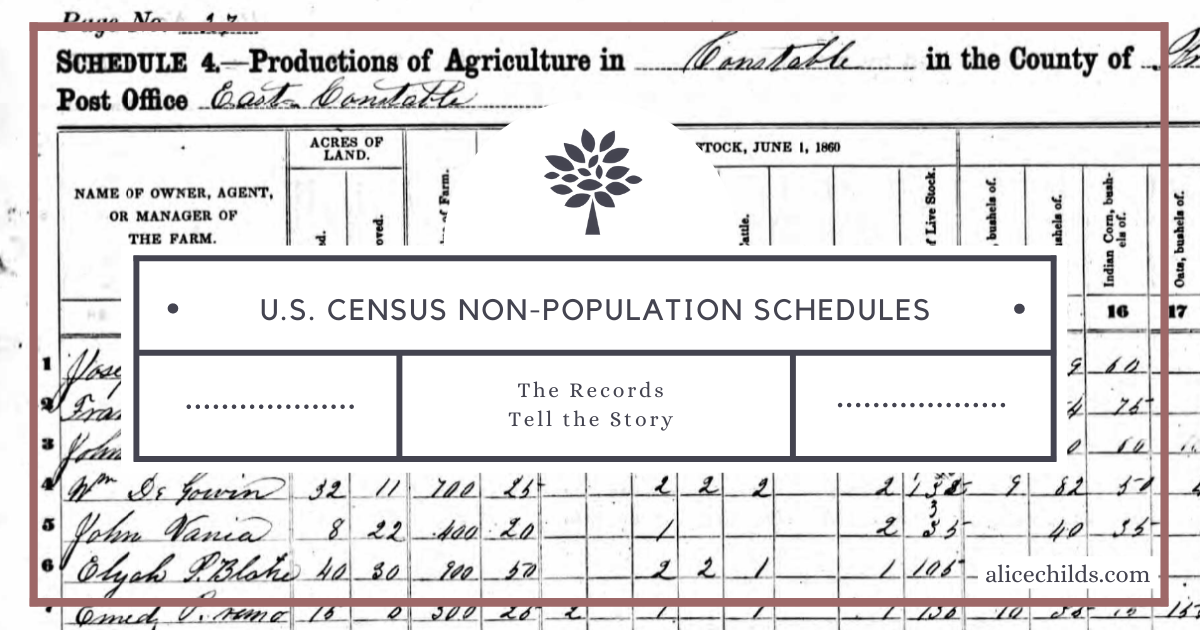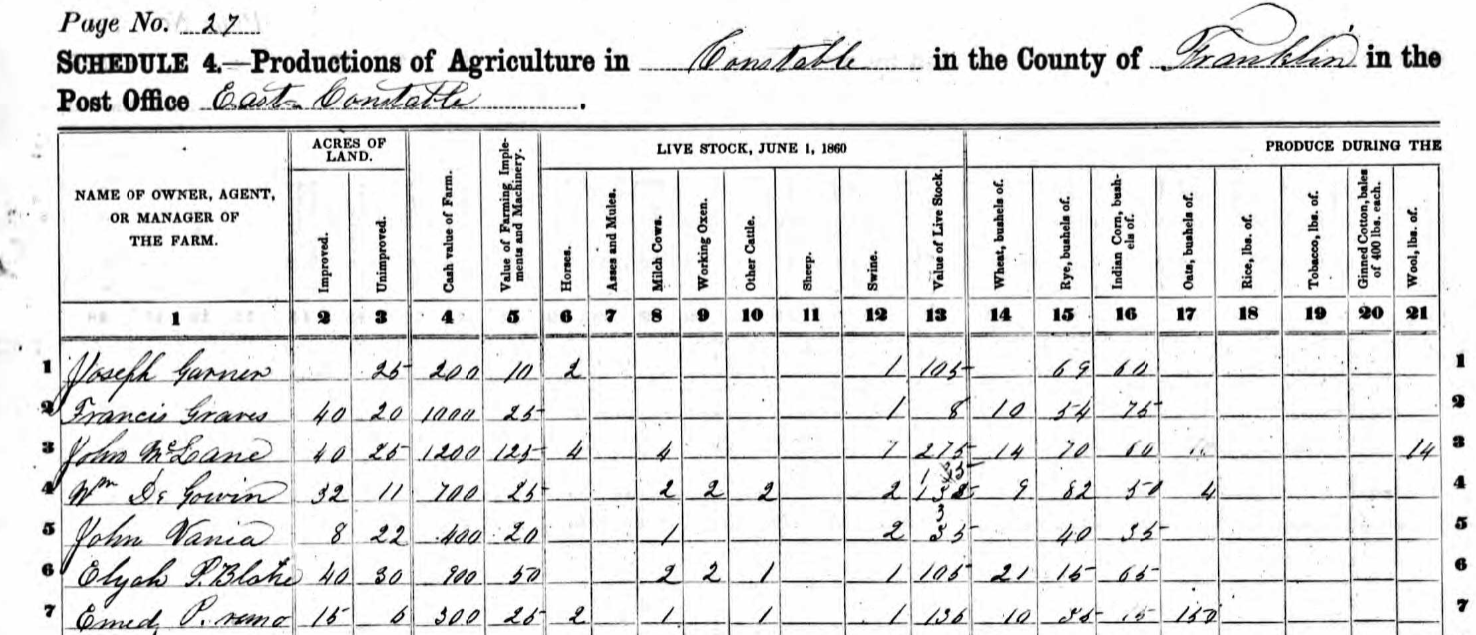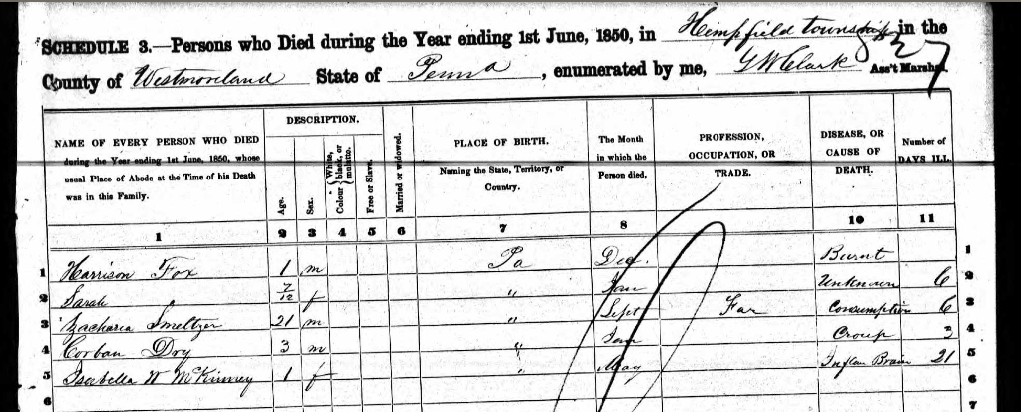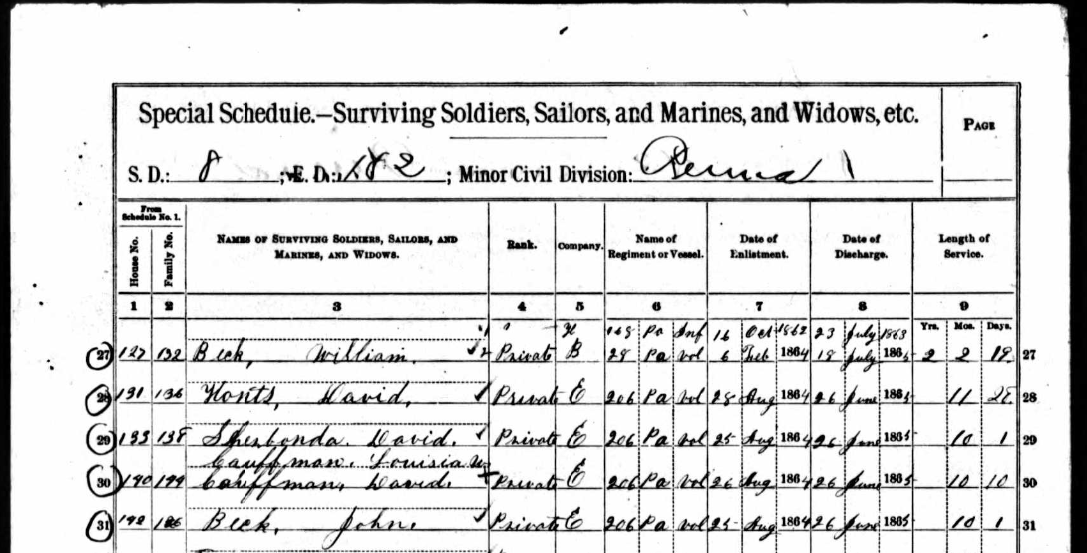
When I began to get serious about genealogy research, I thought I was pretty familiar with census records. I quickly learned I didn’t realize how to maximize the value of these records, which was the topic of my last post. Another thing I quickly learned was that there were different types of census schedules. The census schedule most people are familiar with is called a “population schedule.” This schedule is consists of a listing of each household in a geographical area, with heads of household listed by name prior to 1850 and each member of every household listed by name from 1850 on. Other census schedules are called “non-population schedules” and they too can play a huge role in helping us learn more about our ancestors. These schedules each covered the year preceding the taking of the census. There are several different non-population schedules. I will discuss each one, explain its value, and provide examples of how I have used some of them in my research.
Agricultural Schedules
Agricultural schedules were taken in 1850, 1860, and 1870, and 1880. These are basically lists of farm owners and details about their farms. It’s important to note that very small farms were not typically included on these schedules. The schedules provide information that includes the name of the farm owner, acreage, livestock, goods produced, and cash value of the farm. How would an agricultural schedule be useful? While population schedules can tell us that our ancestor owned a farm, seeing the details included on the agricultural schedule can provide a better picture of what day-to-day life might have been like for our ancestors. Look at the differences between farm acreage, animals owned, and crop production illustrated on the 1860 agricultural schedule from Constable, Franklin County, New York below:

Comparing the farms of John McLane on line 3 and John Vania on line 5, it is clear to see that McLane’s 40 acres of improved land had much greater value, more livestock and greater crop production than did Vania’s 8-acre farm.
Manufacturing Schedules
Manufacturing schedules provide details about manufacturing operations that produced goods greater than $500 in the year prior to the census enumeration. These schedules were created in 1820 and 1850-1880. They include information about the type of business, number of employees, raw materials used, and value of goods produced. There is value in these schedules even if your ancestor didn’t own one of the industries listed. Looking at a manufacturing schedule for the place your ancestor lived can give you a better idea of what jobs were available and what life might have been like for your ancestor.
For example, if your ancestor immigrated to New York, ending up in Cohoes, Albany County, he or she might have been employed in one of the numerous clothing manufacturing companies in Cohoes. In the example below, we can see that Bailey Manufacturing Company appears to have been a fairly large company, using 150,000 pounds of cotton, 45,000 pounds of wool, dyestuff, fuel, and other materials to make thousands of shirts and drawers valued at a total of $95,000. They employed 40 male laborers who earned an average of $25 per month and 100 female laborers who earned an average of $7 per month. These statistics provide a better picture of what life might have been like for an immigrant ancestor who was a laborer in one of these factories than would the occupation “laborer” listed on a population schedule.

1860 U.S. census, Albany County, New York, population schedule, Cohoes, page 2 (penned), line 4, Bailey Manufacturing Company; image, “U.S., Selected Federal Census Non-Population Schedules, 1850-1880,” Ancestry (https://ancestry.com : accessed 7 May 2021); citing NARA microfilm publication I3, Roll 78.
Mortality Schedules
Mortality schedules list every person who died in the year prior to the census enumeration. They are available for the years 1850-1880 and 1885. Because vital records did not begin until much later in most states, a deceased person’s listing on a mortality schedule can substitute as a death record for that individual. The schedules include name, age, sex, marital status, state or country of birth, month of death, occupation, cause of death, and length of final illness. If your ancestor died in the year prior to a census enumeration, it will be well worth your time to locate them on the mortality schedule. Note the details about the four children’s deaths in Hempfield Township, Westmoreland County, Pennsylvania below. This could be the only record for some of them, as they were born and died between census years.

Social Statistics Schedules
Social Statistics schedules are similar to manufacturing schedules in that they provide a better picture of the communities our ancestors lived in. These schedules are available for 1850-1880. They provide details about the valuation of real and personal estates and amounts paid in taxes in a geographical location. They also list colleges/academies/schools, libraries, newspapers, churches, seasons/crops, pauperism, crime, and wages. Social Statistics Schedules are a great resource for discovering the churches in a particular location so church records for our ancestors can be sought. I used a social statistics schedule in some of my research to determine why two sons of one of my ancestors would have been living in a place I had not come across in my research to date: Mississinewa. Further research revealed that Mississinewa was only in existence for a short time around 1850. The 1850 social statistics schedule showed that there was an academy there with 20 pupils. Perhaps these two brothers, age 18 and 20 who were listed as “students” in Mississinewa on the 1850 census were students at this academy.

Business Schedules
The 1935 Census of business is basically a business directory for the entire United States that listed businesses in fifteen different categories. Schedules for some categories have been microfilmed by the National Archives. Others were retained in paper form. These census schedules are not available online.
1890 Veterans Schedules
Another very helpful schedule that isn’t necessarily classified as a nonpopulation schedule, but as a “Special Schedule” is the 1890 Veterans Schedule. Its official name is Special Schedules of the Eleventh Census (1890) Enumerating Union Veterans and Widows of Union Veterans of the Civil War. As the name suggests, it lists Union veterans of the Civil War and their widows (if the soldier had died prior to 1890). It includes the veteran’s rank, company, regiment, dates of enlistment and discharge, and length of service. At the bottom of each page are the post office address for each veteran or widow, further details about injuries or disabilities incurred due to the veteran’s service and other notes. In the example below, my ancestors William Beck, David Honts, and John Beck were all listed. The information about their company, regiment, and service dates can lead to further discoveries about the actions of the company during the war, along with service records and pension records.

Coverage and Availability of Nonpopulation Schedules
To see which nonpopulation schedules are available for the geographic area of interest, visit the National Archives’ web page, Nonpopulation Census Records. Scrolling down on this page will bring you to a list of “Nonpopulation Census Schedules by State, 1820-1930.” Click the “+” symbol next to any state to see which schedules are available for that state and where they might be located.
FamilySearch has digitized a number of nonpopulation schedules. Some have been indexed, others have not. Some are in locked collections and available only at a FamilySearch center. Consult their Coverage Table in the FamilySearch Research Wiki to learn what is available for your state of interest.
Ancestry has two digitized collections for nonpopulation schedules:
- U.S., Selected Federal Census Non-Population Schedules, 1850-1880 includes agriculture, industry/manufacturers, social statistics, and supplemental schedules for 21 states. The collection is searchable or browsable.
- U.S., Federal Census Mortality Schedules, 1850-1885 is also searchable or browsable. Choose the year and state in the “Browse this collection” box on the right side of the screen to see if the schedules for your state and county of interest are included before searching the database.
The 1890 Veterans’ Schedules are digitized at both Ancestry and FamilySearch. Aside from a few random returns, data for the states of Alabama through Kansas do not exist. FamilySearch’s collection includes those miscellaneous returns. Ancestry’s does not.
- FamilySearch’s collection is titled United States Census of Union Veterans and Widows of the Civil War, 1890. It includes data for the states of Kentucky through Wyoming.
- Ancestry’s collection is titled 1890 Veterans Schedules of the U.S. Federal Census.
If you haven’t yet used nonpopulation schedules in your research, think of how they might benefit you and help you add details to the stories of your ancestors’ lives. Then jump in and see what you can find.
Additional Reading:
“Nonpopulation Census Records,” National Archives (https://www.archives.gov : accessed 7 May 2021).
“United States Census Records Nonpopulation Census Schedules – 1820, 1850-1880,” FamilySearch Research Wiki (https:/www.familiysearch.org : accessed 7 May 2021).
“Special Schedules of the Eleventh Census (1890) Enumerating Union Veterans and Widows of Union Veterans of the Civil War. M123. 118 rolls,” National Archives (https://www.archives.gov : accessed 7 May 2021).
“United States Census Veterans Schedules,” FamilySearch Research Wiki (https://www.familysearch.org : accessed 7 May 2021).
